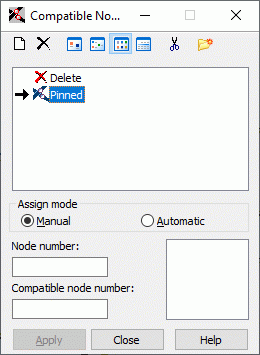Open the Compatible Nodes dialog using one of the following methods:
- Click Geometry menu > Additional attributes > Compatible nodes.
- Click
 .
.
This dialog is used to define compatible nodes in a structure. It means that one defines shared nodes with respect to displacement or rotation for the selected degrees of freedom in the points where structure bars are connected (compatibility). Selected nodes are copied. Each node belongs to a different set of bars. All the degrees of freedom in a node, except those indicated by the user, are mutually independent.

For bar structures with intersecting bars, you can get the same values of displacement for bars at their intersection point. To achieve this, use the Compatible Nodes option. The number of nodes with identical coordinates must be the same as the number of bars. Each node belongs to a different bar.
The dialog has the following:
- At the top, there are several icons
- A field displaying the active list of compatible node types
- At the bottom, there are the following fields: node number, compatible node number, node number presentation field, current selection field, and the standard buttons
The dialog has the following icons:
 - Adds a new compatibility type (Definition of a new type of compatibility)
- Adds a new compatibility type (Definition of a new type of compatibility)  - Deletes a selected type of compatibility from the active list
- Deletes a selected type of compatibility from the active list  ,
,  ,
,  , and
, and  - Displays the list of active compatibility types as: big icons, small icons, short list, and full list
- Displays the list of active compatibility types as: big icons, small icons, short list, and full list  - Deletes from the active list all the compatibility types that are not in the designed structure
- Deletes from the active list all the compatibility types that are not in the designed structure  - Opens the Label Manager dialog.
- Opens the Label Manager dialog.
Similar to defining other structure attributes, the process of defining compatibility in a structure is divided into 2 steps:
- Defining compatibility type
If the active list of compatibility types is empty or a new compatibility type is to be added to the active list, click new compatibility type:
- If none of the compatibility types is selected; clicking
 opens the dialog for a new compatibility type definition. The fields are filled with the last compatibility definition (except for the LABEL field) or the default parameters are set.
opens the dialog for a new compatibility type definition. The fields are filled with the last compatibility definition (except for the LABEL field) or the default parameters are set. - If a compatibility type is highlighted, clicking
 opens the dialog to define a new compatibility type. All fields (except for the LABEL field) are filled using the highlighted type.
opens the dialog to define a new compatibility type. All fields (except for the LABEL field) are filled using the highlighted type.
You can also open the dialog for a new compatibility type by double-clicking on the element from the active compatibility types list. The Compatibility Definition dialog opens with all fields filled according to the compatibility type selected. After changing the required parameters, the compatbility type is added (updated) to the active list by clicking ADD or pressing <ENTER>. If you do not change the label, an appropriate warning displays (as in the case of a new compatibility definition.) This option lets you change compatibility types.
- If none of the compatibility types is selected; clicking
- Defining compatible nodes.
To delete a compatibility type from the structure:
- Click
 on the active compatibility type list,
on the active compatibility type list, - Select an object in the structure you want to delete the compatibility type from
You cannot modify this type of compatibility type; it is assigned the same way as the compatibility type properties are to a structure element.
After you define a compatibility type, its symbol is displayed.
See also:
